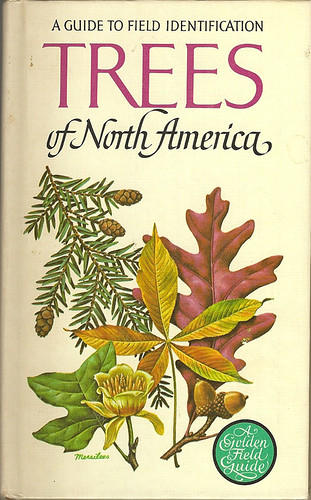As luck would have it, I arrived in the city last Friday evening a tad too early for a scheduled gathering at the headquarters of one of my old graduate schools. Not wanting to sit twiddling my thumbs in a lobby before the doors opened, I pointed the Prius down the street to the downtown location of Powell’s Books in Portland, Oregon for a little pre-event shelf perusing. After half an hour, I walked out with an early hardcover edition of Rachel Carson’s The Sea Around Us and a second book, specifically about trees, from a series that whenever I read one, I feel as if I have bitten directly into Proust’s famous madeleine and been transported right back to my childhood; this series being the famous Golden Nature Guides.

When I was but a lad attending Captain Robert Gray Elementary School in Astoria, Oregon, I discovered the wonders to be found in the Golden Guides during my second grade year. The volume was that one covering fishes of both salt and fresh water environments. My father being a commercial fisherman and my mother working for the administrative offices of Bumble Bee Seafoods, I had spent my entire life to that point growing up not only in a family that made its living from fishing but in an entire town located on one of the most active commercial fishing ports along the western coast of the United States. Naturally, I was drawn to any book about what I had spent my life learning simply by being alive and awake. However the Golden Guide to Fishes was not simply a recitation of what I already knew, it was a key to a vast storehouse of knowledge about strange and wonderful creatures and environments I could at that time scarcely believe existed.
I think I filled out two entire library check-out cards with all the dates I borrowed that little blue hardcover book from the school library. Not only was it interesting, it was fun to read. Being a combination of straight-forward text generously interwoven with colorful illustrations about not only the fish themselves but their environment, the people who study as well as the people who make their living from catching them, and a host of other pertinent subjects, the Golden Guide style was perfect for a young and curious mind to explore. The authors of the guides had a remarkable style of writing – neither too complex to dissuade a beginner nor too simple to irritate an enthusiast. It seemed that whatever one’s level, the author (or authors, as the guides were often a team effort) was ready to meet the reader exactly where he or she was ready to begin learning.
From that experience, I quickly came to discover that regardless of the subject, if the book bore the Golden Guide name, it was a book that I would find interesting to read and be written in a manner that whether I knew absolutely nothing or had considerable experience with the subject I would consider the reading of it time well spent. As a result, I still to this day collect and read with unabashed enjoyment the old, increasingly scarce hardcover copies of the early editions of the Golden Nature Guides and Golden Field Guides. I also recommend them to young people voicing an interest in learning one of the natural sciences for which a volume of the guides was published.
Golden Guides were originally released to a splendid public reception in 1949 by Simon and Schuster, and were a mainstay of budding naturalists all across America for decades. While being allowed to languish for many years toward the latter part of the last century, thanks to an ambitious project undertaken by St. Martin’s Press (a division of Macmillan Publishers) they were updated and relaunched in 2000, and as of this writing can boast thirty-four different volumes in print.
If you enjoyed reading this, please consider signing up for The Well-read Naturalist's newsletter. You'll receive a helpful list of recently published reviews, short essays, and notes about books in your e-mail inbox once each fortnight.
